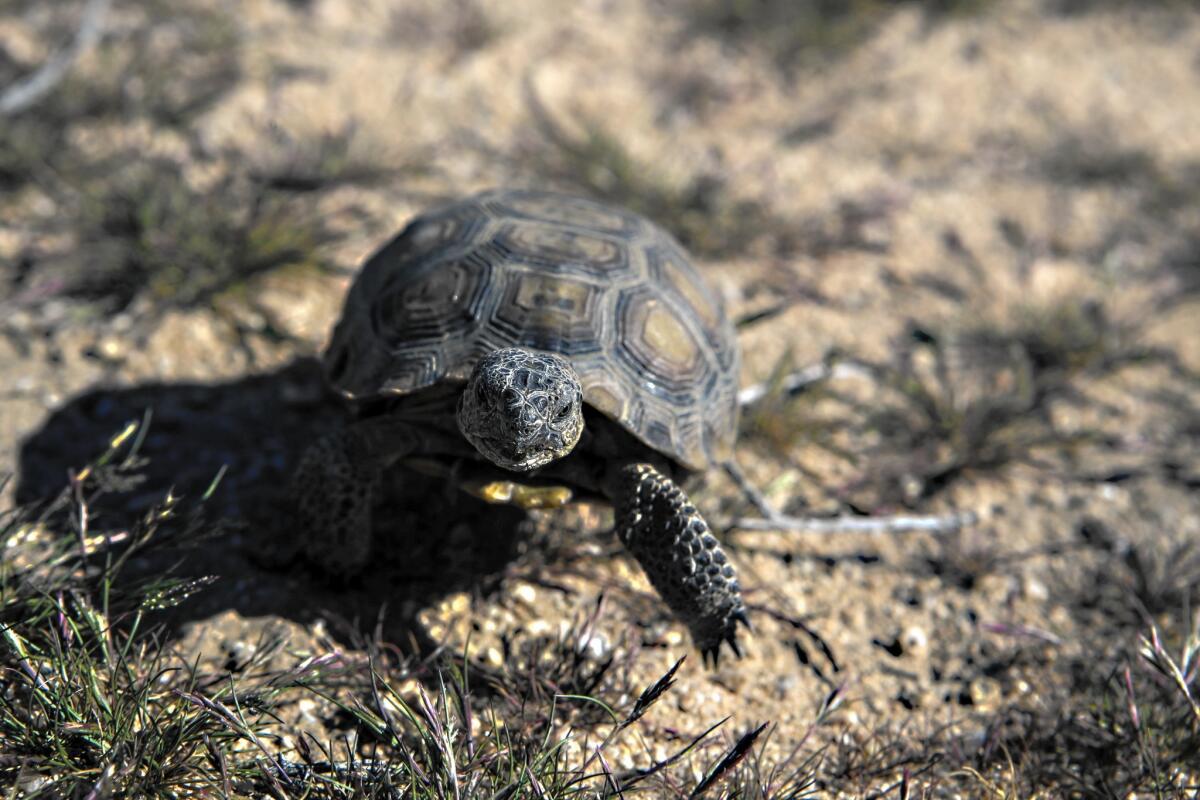The Marine Corps is planning a $50-million effort to help save desert tortoises. But will it work?

One of the largest translocations of tortoises ever to be undertaken is expected to launch this month as mitigation for congressional approval to expand the Marine Corps’ Air Ground Combat Center in 29 Palms by about 165 square miles, much of it pri
- Share via
reporting from TWENTYNINE PALMS, Calif. — The Marine Corps is gearing up to airlift 1,185 desert tortoises from prospective combat training grounds to nearby terrain where they won’t be crushed by military equipment.
One of the largest translocations of tortoises ever to be undertaken is expected to launch this month as mitigation for congressional approval to expand the Marine Corps’ Air Ground Combat Center by about 165 square miles, much of it prime habitat.
But there is concern that the $50-million effort will hasten the disappearance of federally threatened tortoises in California’s drought-stricken Mojave Desert, where the number of breeding adults has fallen by about 50% over the last decade, according to a recent survey by federal biologists.
The region saw similar declines of adult tortoises from the 1970s to the 1990s. Studies of tortoise carcasses at the time revealed many causes of death: trampling by livestock, crushing by vehicles and diseases introduced by pet tortoises released into the wild. A large percentage of animals were shot.
NEWSLETTER: Get the day’s top headlines from Times Editor Davan Maharaj >>
“I wish the U.S. Fish and Wildlife Service would get some backbone and say it can’t permit another tortoise translocation by the military,” said Glenn Stewart, a biologist and member of the board of directors of the Desert Tortoise Council conservation group. “The situation makes us feel like we’ll have to write off California’s Mojave population.”

William Boarman, a wildlife scientist and expert on the desert tortoise, said relocation “is not a conservation strategy or a means of helping tortoise populations grow. It is simply a way of moving them out of harm’s way.”
But Walter Christensen, head of environmental planning at the base, is optimistic. “We’ve learned a lot from past mistakes of others,” he said. “We wouldn’t be doing this if we felt the desert tortoise wasn’t viable in the Mojave.”
Tortoise translocation has a dismal track record. The stress from handling by humans and then adapting to unfamiliar terrain renders the reptiles vulnerable to lethal threats, including predation by dogs, ravens and coyotes; respiratory disease; dehydration; and being hit by vehicles.
It also disrupts complex tortoise social networks and genetic lines linked for thousands of years by Mojave Desert kingdoms of trails, arroyos and hibernation burrows fringed with creosote. Those habitats are being irreversibly fragmented and destroyed by off-road vehicles, urban encroachment and development of utility corridors and massive green-energy facilities.
Critics point to the Army’s catastrophic effort to move 670 tortoises from its National Training Center near Barstow in March 2008 to new homes in the western Mojave.
That $8.6-million project was suspended less than a year later because 90 translocated and resident tortoises in those areas died, many of them killed and eaten by coyotes.
The problem was linked to drought-stricken foraging grounds, which killed off plants and triggered a crash in rodent populations. As a result, coyotes, which normally thrive on rodents and rabbits, began feasting on tortoises, which are protected by state and federal Endangered Species Acts.
Other threats included respiratory disease, which was prevalent in the relocation area and transmitted to the newcomers.
Brian Henen, a biologist and head of the Marine Corps’ translocation effort, said the project’s significant budget and commitment to monitor the health of the tortoises for 30 years “demonstrates how much we care about this species.”
Under the plan approved by the U.S. Fish and Wildlife Service, about 100 contract biologists will help capture 900 adult tortoises — most of them outfitted with radio transmitters — in the expansion area. The animals will be released in three sites on military property and nearby public lands.
An additional 235 juveniles raised in pens at the base until they are large enough to ward off birds that eat thin-shelled babies will also be relocated. The process will take an estimated two to four weeks to complete, officials said.
Their chances of becoming breeding adults, however, are not good.
From 2004 to 2014, 9,136 wild and pet tortoises were moved from a desert tortoise conservation center in Las Vegas to a federal translocation study site near Jean, Nev. Only 370 of them could be found during a survey conducted last year.
“Things are obviously not fine — tortoise populations are not holding their own,” said Linda Allison, a biologist with the Fish and Wildlife Service. “Since we are trying to recover the species, it is terrible that they are declining.”
There is one place in the Mojave Desert, however, where the species is flourishing: the fenced Desert Tortoise Natural Area near California City, which has some of the highest known densities of the reptiles in the United States.
Twitter: @LouisSahagun
ALSO
A Wilmington neighborhood is an island in a sea of petroleum
Possible new octopus species found near Hawaii, scientists say
Op-Ed: Are we greening our cities, or just greenwashing them?




